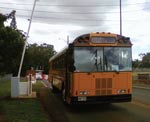
Running the Gate
Army Barracks in Hawaii now protected from car and truck bombers
- By David Dickinson
- Jan 04, 2010
After the 1983 bombing of the
Marine barracks in Lebanon,
the Defense Department has
been consistently upgrading vehicle access
to military bases and their living
quarters worldwide. The latest anti-terrorist
perimeter access control improvements
are being phased in at Schofield
Barracks and Fort Shafter on Hawaii's
island of Oahu.
Schofield Barracks, with a population
of more than 4,000, is the largest Army
post in Hawaii, located on an 18,000-
acre site in central Oahu. Since 1941, it
has been the home of the 25th Infantry
Division, known as the Tropic Lightning
Division, as well as the command
headquarters for U.S. Army Hawaii.
Schofield Barracks also is home to the
8th Theater Sustainment Command.
As a result of the closure of U.S.
military installations in Panama, the
Tropic Regions Test Center was relocated
to Hawaii, and the East Range at
Schofield Barracks provides a location
for soldier system and chemical-biological
defense testing.
On Oahu, U.S. Army, Pacific, commands
most Army forces in the Asia-
Pacific region with the exception of Korea.
It is headquartered on Fort Shafter
with more than 5,000 soldiers, civilians,
contractors and military families living
and working on the 589-acre post.
Closing the Gaps
Between the two locations, there are 11
entrances—eight at Schofield and three
at Shafter. The main entrances at both
posts use crash barriers for protection,
while all other entrances are guarded
with drop-arm barricades. Each entrance
uses a trapping technique to stop
errant vehicles.
When determining how to protect
Schofield and Shafter, officials found
there were several options regarding how
to proceed. In most perimeter access
control situations, the barricade or gate
is positioned directly on the perimeter to
stop the vehicle right at the boundary.
The barricade or gate is kept closed to
ensure no vehicle can enter and is opened
to let authorized vehicles through.
With thousands of people coming
and going each day, this was impractical
at the barracks. Plus, the Army
decided it wanted to go a step further.
While officials wanted to ensure that
no truck or car bomber could get far
enough onto the base to inflict damage,
they also wanted to be able to entrap
other types of errant vehicles and apprehend
perpetrators.
Therefore, at all 11 entrances, there
is a screening area where a guard stops
all vehicles and checks identification.
If everything is fine, the vehicle is authorized
to continue onto the base.
However, if a non-authorized vehicle
ignores the guard or forces its way onto
the base, the guard activates the vehicle
access system, which stops the car dead
in its tracks.
Additional Concerns
For aesthetic reasons, the Army decided
to place Delta DSC501 high-security
barricades at the main entrances at
Schofield and Shafter. The blade is kept
below ground and only raised in case
of emergency, providing a cleaner look.
The Army also was concerned with infrastructure
problems, such as buried
pipes, power lines, fiber-optic communication
lines and other systems that
are installed along the main entrances.
With a shallow foundation of only
18 inches, the DSC501 eliminated these
concerns, reducing installation complexity,
time, materials and costs. The
units were installed within a week.
Front-face warning lights warn drivers
that the barricade is in the raised position,
and there is an open area on the
front for signage.
Up to the Challenge
A car traveling 60 miles per hour can be
detected within 90 feet, and the DSC501
takes only 1 second to raise, enough
time for the barricade to provide protection.
In the lowered position, the
barrier ramp is completely flush with
the roadway. Buttresses, counterweights
and road plates do not obstruct authorized
pedestrian or vehicular traffic.
Since the main entrances come off
more heavily traveled roads, the vehicle
control system also needed to be
able to stop the biggest vehicles. This
barricade's K54 testing exceeds government
mandates, meaning the barricade
not only stopped and destroyed
a 65,000-pound dump truck traveling
50 miles per hour (5.4 million footpounds)
but was capable of preventing
a potential second attack. In other
words, the barricade system survived
the K54 impact with all major elements
intact. It was repaired and operating in
only three hours.
The other 11 entrances at the two
bases use drop-beam barricades because
they cover a wider lane at a lower
cost. This same Delta DSC7000 beam
barricade is used worldwide at locations
where wide roadways need to be
secured from attacking vehicles.
It provides 12 to 200 feet of width
protection with options to extend to 30
feet. The 725-pound beam of the vertical
lift barricade completely stops a
15,000-pound vehicle traveling 50 mph,
equivalent to 1.2-million foot-pounds
of kinetic energy, and meets the K12
crash certification standard set by the
State Department. Each beam barricade
takes about five days to install.
At Schofield and Shafter, the barricade
is left in the upright position at all
times. In case of emergency, the guard
drops the beam. Providing a 0.7 second,
emergency fast closing time, the
DSC7000 beam barricade meets and exceeds
multiple agency standards for closing
time requirements, including DOS,
DOD, Army Corps of Engineers Access
Control Points and Army Corps of Engineers,
Emergency Fast Operating.
Similar systems are used at other
Army locales, as well as at Navy and
Air Force bases, worldwide. The first
DSC501 was built for the Navy and
installed at a Navy base while the Air
Force has deployed
more than 540 of the
barricades.